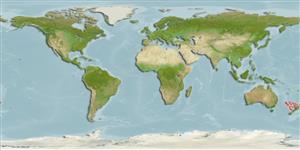Teleostei (teleosts) >
Gadiformes (Cods) >
Macrouridae (Grenadiers or rattails)
Etymology: Coelorinchus: Greek, koilos = a hollow + Greek, rhyngchos = jaw (Ref. 45335).
Environment: milieu / climate zone / depth range / distribution range
Ecology
Marine; bathydemersal; depth range 833 - 1150 m (Ref. 26363). Deep-water; 32°S - 42°S
Southwest Pacific: Wanganella Bank, Challenger Rise, and New Zealand.
Size / Weight / Age
Maturity: Lm ? range ? - ? cm
Max length : 49.0 cm TL male/unsexed; (Ref. 26363)
Short description
Identification keys | Morphology | Morphometrics
Dorsal spines (total): 2. Fully-scaled underside of head and lower jaw; snout long, length 44.5-51.4% HL, dorsal anterior surface upturned in lateral profile; area anterior to and below nostrils covered with scales between nostrils and suborbital ridge; light organ lacking obvious ventral dermal window; anterior of the anal fin dusky, pale posteriorly (Ref. 26363). Similar to a number of moderate- to long-snouted Caelorinchus species which lack distinguishing body or fin markings but may be differentiated from each other based on their body proportions, among other characters (Ref. 26363).
Body shape (shape guide): elongated.
A benthic species found on the continental slope (Ref. 75154).
Life cycle and mating behavior
Maturity | Reproduction | Spawning | Eggs | Fecundity | Larvae
McMillan, P.J. and C.D. Paulin, 1993. Description of nine new species of rattails of the genus Caelorinchus (Pisces, Macrouridae) from New Zealand. Copeia 1993(3):819-840. (Ref. 26363)
IUCN Red List Status (Ref. 130435: Version 2025-1)
Threat to humans
Harmless
Human uses
Tools
Special reports
Download XML
Internet sources
Estimates based on models
Preferred temperature (Ref.
123201): 5.2 - 6.4, mean 6 °C (based on 19 cells).
Phylogenetic diversity index (Ref.
82804): PD
50 = 0.5000 [Uniqueness, from 0.5 = low to 2.0 = high].
Bayesian length-weight: a=0.00245 (0.00126 - 0.00477), b=3.19 (3.02 - 3.36), in cm total length, based on LWR estimates for this Genus-body shape (Ref.
93245).
Trophic level (Ref.
69278): 3.6 ±0.5 se; based on size and trophs of closest relatives
Resilience (Ref.
120179): Low, minimum population doubling time 4.5 - 14 years (Preliminary K or Fecundity.).
Fishing Vulnerability (Ref.
59153): Moderate vulnerability (39 of 100).
🛈
